
The Disappearing Sands: How Climate Change is Redefining Europe's Summer Destinations
Once celebrated for their sun-kissed beaches and vibrant holiday culture, places like Montgat, Spain, are now grappling with the realities of climate change. Traditional summer images of families building sandcastles are becoming relics of the past as increasingly violent storms wash away the sand those families once played on. What was once a prime retreat is now a testament to the destructive capabilities of nature.
The Rising Heat: Europe’s New Summer Norms
In recent years, the summer heat in Southern Europe has become not only unbearable but dangerous. This summer saw record-breaking temperatures across Spain, Italy, and Greece, resulting in health warnings and a decline in tourist visits as many travelers reconsider their plans. The melting of glaciers and rising sea levels accentuate the urgency of climate action, leaving many questioning whether traditional vacation spots will continue to exist in the years to come.
Environmental Impact: A Broader Perspective
As summer heat waves become more frequent, the effects extend beyond just tourism. Local inhabitants find themselves in increasingly hostile environments, suffering from health issues due to extreme heat. Climate scientists also warn that natural disasters experienced more often today—floods, wildfires, and storms—threaten entire ecosystems, disrupting both human and animal life. Even domestic industries catering to tourism find themselves at risk, with fluctuating seasons impacting business stability.
Changing Travel Behaviors: Seeking New Paradises
With the reality of climate change weighing heavily on popular destinations, many tourists are starting to seek alternative vacation spots. Coastal regions once thought idyllic are starting to lose their luster, prompting travelers to seek out more temperate climates or unexplored locations that may offer a reprieve from climate-related issues. Countries in Northern Europe—with their cooler climates and well-preserved natural landscapes—are gaining attention as potential new summer havens.
The Silver Lining: Environmental Activism and Adaptive Strategies
While the plight faced by traditional summer destinations is alarming, it has also ignited a sense of community and activism. Local groups are advocating for sustainable tourism and better environmental practices. Cities are reevaluating their relationship with tourism and implementing stricter guidelines to reduce ecological footprints. By prioritizing ecological sustainability, there’s hope that the traditions of summer travel can evolve, incorporating environmentally friendly practices that benefit both locals and visitors.
A Call to Reflection: What Now?
The compounding pressures of climate change compel individuals and governments to consider how our actions are shaping the landscapes of tomorrow. By acknowledging the fragile nature of these cherished summer retreats, we might find ways to preserve their beauty for future generations. Education and advocacy are key components in this journey, as informing one another about climate change's impacts can lead to more responsible travel choices.
As this summer draws to a close, let us reflect carefully on how we engage with our environment, ensuring that our love for travel does not come at the expense of our planet’s health. The future of summer vacations and cherished places may depend on the decisions we make today.
 Add Row
Add Row  Add
Add 




 Add Row
Add Row  Add
Add 

Write A Comment